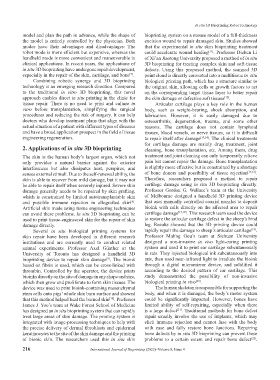Page 224 - IJB-8-4
P. 224
In situ 3D Bioprinting Robot Technology
model and plan the path in advance, while the shape of bioprinting system on a mouse model of a full-thickness
the model is entirely controlled by the physician. Both excision wound to repair damaged skin. Studies showed
modes have their advantages and disadvantages: The that the experimental in situ skin bioprinting treatment
robot mode is more efficient but expensive, whereas the could accelerate wound healing . Professor Dichen Li
[11]
handheld mode is more convenient and maneuverable in of Xi’an Jiaotong University proposed a method of in situ
clinical applications. In recent years, the applications of 3D bioprinting for treating complex skin and soft-tissue
in situ 3D bioprinting have undergone rapid development, defects. Using this proposed method, the scanned 3D
especially in the repair of the skin, cartilage, and bone . point cloud is directly converted into a multitissue in situ
[7]
Combining robotic synergy and 3D bioprinting biological printing path, which has a structure similar to
technology is an emerging research direction. Compared the original skin, allowing cells or growth factors to act
to the traditional in vitro 3D bioprinting, this novel on the corresponding target tissue layer to better repair
approach enables direct in situ printing in the clinic for the skin damage or defective soft tissues .
[12]
tissue repair. There is no need to print and culture in Articular cartilage plays a key role in the human
vitro before transplantation, simplifying the surgical body, such as weight-bearing, shock absorption, and
procedures and reducing the risk of surgery. It can help lubrication. However, it is easily damaged due to
doctors who develop treatment plans that align with the osteoarthritis, degeneration, trauma, and some other
actual situation of a patient with different types of diseases reasons. The cartilage does not contain lymphoid
and have a broad application prospect in the field of tissue tissues, blood vessels, or nerve tissues, so it is difficult
engineering regeneration. to repair itself after damage [13,14] . The clinical treatments
for cartilage damage are mainly drug treatment, joint
2. Applications of in situ 3D bioprinting cleaning, bone transplantation, etc. Among them, drug
The skin is the human body’s largest organ, which not treatment and joint cleaning can only temporarily relieve
only provides a natural barrier against the exterior pain but cannot repair the damage. Bone transplantation
interferences but also dissipates heat, perspires, and is slightly more effective but is constrained by a shortage
senses external stimuli. Due to the self-renewal ability, the of bone donors and possibility of tissue rejection [15,16] .
skin is able to recover from mild damage, but it may not Therefore, researchers proposed a method to repair
be able to repair itself when severely injured. Severe skin cartilage damage using in situ 3D bioprinting directly.
damage generally needs to be repaired by skin grafting, Professor Gordon G. Wallace’s team at the University
which is constrained by limited autotransplantable skin of Melbourne designed a handheld 3D printing device
and possible immune rejection in allografted skin . that uses manually controlled coaxial nozzles to deposit
[8]
Artificial skin made using tissue engineering techniques bioink with cells directly on the affected area to repair
can avoid these problems. In situ 3D bioprinting can be cartilage damage [17,18] . This research team used the device
used to print tissue-engineered skin for the repair of skin to restore the articular cartilage defect in the sheep’s hind
damage directly. leg. Results showed that the 3D printing device could
Several in situ biological printing systems for rapidly repair the damage to sheep’s articular cartilage .
[19]
skin repair have been developed in different research Professor Maling Gou’s team at Sichuan University
institutions and are currently used to conduct related designed a non-invasive in vivo light-curing printing
animal experiments. Professor Axel Günther at the system and used it to print ear cartilage subcutaneously
University of Toronto has designed a handheld 3D in rats. They injected biological ink subcutaneously into
bioprinting device to repair skin damage . The bioink rats, then used near-infrared light to irradiate the bioink
[9]
based on fibrin is used, which can be cross-linked with through a digital micromirror device, and solidified it
thrombin. Controlled by the operator, the device prints according to the desired pattern of ear cartilage. This
bioinks directly on the site of damage in any shape and size, study demonstrated the possibility of non-invasive
which then grow and proliferate to form skin tissues. The biological printing in vivo .
[20]
device was used to print bioink-containing mesenchymal The human skeleton is responsible for supporting the
stem cells onto pigs’ whole skin burn surface and showed body, and when it is damaged, the body’s motor system
that this method helped heal the burned skin . Professor could be significantly impacted. However, bones have
[10]
James J. Yoo’s team at Wake Forest School of Medicine limited ability of self-repairing, especially when there
has designed an in situ bioprinting system that can rapidly is a large defect . Traditional methods for bone defect
[21]
treat large areas of skin damage. The printing system is repair usually involve the use of implants, which may
integrated with image-processing techniques to help with elicit immune rejection and cannot fuse with the body
the precise delivery of dermal fibroblasts and epidermal with ease and fully restore bone functions. Repairing
keratinocytes to the site of the skin damage and the printing bone defects by in situ 3D bioprinting can prevent these
of bionic skin. The researchers used this in situ skin problems to a certain extent and repair bone defect .
[22]
216 International Journal of Bioprinting (2022)–Volume 8, Issue 4

